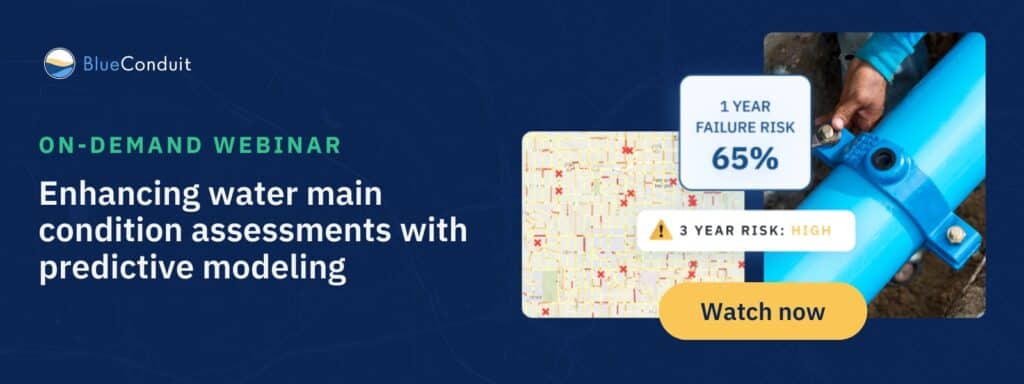Did you know that Alabama’s drinking water infrastructure got a grade of C- on the most recent Report Card for Alabama’s Infrastructure?
This 2022 report card provides clear and specific recommendations for improving the C- grade for drinking water, including: “Provide resources for infrastructure asset mapping…computerized preventative maintenance and asset management planning, and long-range strategic master planning.”
In short, Alabama’s 587 drinking water systems need proactive solutions to manage water infrastructure risk. Let’s explore key risk factors at play for Alabama utilities and how BlueConduit can help.
Most of Alabama’s drinking water infrastructure was built between the 1870s and 1980s
In Alabama, the majority of drinking water infrastructure is currently 50-100+ years old. Age isn’t the only thing that impacts risk of failure in water mains. But it can often be a contributing factor to water main risk, especially if the pipe has not been well maintained.
This isn’t just an on-paper problem; a simple Google search found over 30 news reports of water main breaks across Alabama in the last few weeks alone (and those are just the ones significant enough to make the news). With mains failing daily and limited funding for replacements, Alabama water system operators need proactive risk management solutions now.
Temperatures have cooled and annual precipitation has increased 5-10% since the mid-1900s
When it comes to shifting climate patterns, Alabama is in a unique position. While most of the country has experienced rising temperatures, Alabama has cooled but also seen precipitation and heavy storms increase dramatically.
Larger swings in temperature and more freeze/defrost cycles, alongside storms that bring heavy precipitation, put pressure on water pipes and add to the risk of leak or failure across the system. Being able to predict how weather impacts risk in a variety of weather scenarios is a huge value-add for system operators who need to get ahead of the risk to limit catastrophic failures and the costs of reactive repairs.
As much as 20% of Alabama’s drinking water is lost as non-revenue water
According to the 2022 Report Card for Alabama’s Infrastructure, “[water] systems currently operate under a mode whereby most resources are expended on fixing leaks and trying to limit non-revenue (unaccounted for) water, rather than on proactive preventive replacement programs. Of the total 831 million gallons withdrawn daily from surface and ground water sources, only 327 million gallons is ultimately billed to system customers.”
Even with new water infrastructure funding available, system needs far outpace available resources
Alabama recently received $43.7M in Bipartisan Infrastructure Law funding for water infrastructure. US Representative Terri Sewell (AL-07) stated, “Access to clean water is a basic human right, and this investment represents critical progress in our continued fight for equitable and safe [water and wastewater] systems.”
He’s right. And yet, even these millions of dollars represent less than 1% of the expected $7.9 BILLION needed for drinking water infrastructure over the next 20 years.
Water systems that are already struggling to cover operational costs (the average statewide operating ratio is 0.79), even with this influx of funding, have only 2 choices: increase rates or decrease costs.
With aging water infrastructure, shifting weather patterns, and limited funding, Alabama’s water systems need better ways to get ahead of risks and limit reactive costs with preventative maintenance and replacement programs.
Here’s where BlueConduit comes in. BlueConduit’s Water Main Predictions tool enables the proactive assessment of risk for underground water pipes, and enables water operators to proactively complete short- and long-term maintenance and repair projects focused on areas of highest risk.
The Water Main Predictions tool enriches water main data with parcel, weather, soil, and other relevant data. BlueConduit’s software, supported by expert Data Scientists to ensure quality, explainability, and accuracy of predictions, then generates likelihood of failure (LoF)predictions for every water main across multiple timeframes. Armed with quality system data, LoF predictions, and criticality data, water system operators can easily and defensively plan for proactive maintenance and replacements.
Russell Lomax,Water & Sewer Operations Manager for the Mobile Area Water and Sewer System (MAWSS), said it best:
“We’re entirely ratepayer driven, so we’re working with a fixed budget. We needed a tool that lets us continually monitor the system and gives us a better way of assessing and planning to address risk. We’re excited to partner with BlueConduit on this critical work.”
Ready to chat about partnering on water main management? Reach out to schedule a consultation today.
Want to learn more about how BlueConduit’s software tool works? Check out our on-demand webinar.






